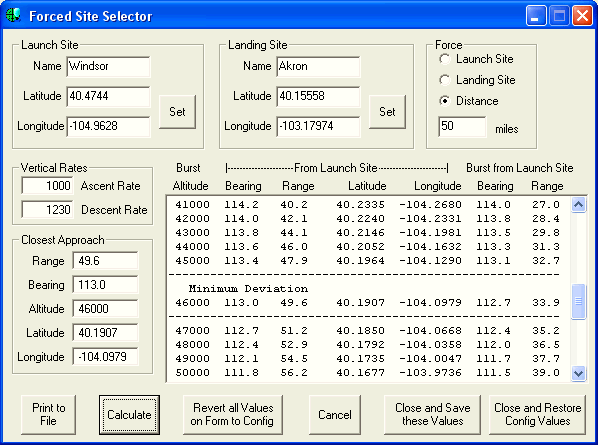Forced Site Selector Screen

Both the Launch Site and the Landing Site locations may now be saved on the Setup Screen.
You can edit these locations from this screen and recalculate to your heart's content. Vertical rates may be changed too. When you have finished with this screen, you have the option to carry the values you entered here back to the main program for use in a new prediction run. But, these values will NOT replace those in the currently active INI file. For that you'd need to go to the setup screen and then save the new values. These new values will carry over to the setup screen, so you won't have to re-enter them.
What's happening on this screen. Well, if you select the Launch site as your "Force Site" then the program will calculate a prediction for every altitude in 1000 foot increments to the maximum wind height or (Burst Altitude as set on the main screen or in the setup screen) in the data file. For each computation, it will compare the distance to the desired landing site. Flying to a particular altitude and bursting will result in the closest approach to the desired landing site. If you have a cut down device, you could theoretically monitor the balloon and cut it down at the altitude that represents the point at which the descent would land the balloon at the closest approach to your desired landing site.
If you select to force the Landing site, then the program does the reverse calculating the latitude and longitude of the closest approach to the launch site the balloon would have had to be launched to make the balloon payload land exactly at the desired landing site. Theoretically, you could then move to that indicated launch site (using GPS I guess) launch the balloon, cut it down at the indicated altitude and have the balloon descend into the back of the pick up truck you are using for recovery operations.
A new option is a Forced Landing at a specified distance (shown in the example screenshot above), click that in the "Force" selection area, enter a range and the program will calculate as above, but this time looking for the ideal altitude to cut down from to achieve the specified range. In the above screen, a forced limit of 50 miles was selected and the program determined that the best cutdown would occur at 46,000 feet.
You can export any of these computations to a file.
Of course, this is just a toy. In reality, winds will change from the time of the data captured by the NWS to the time you fly. And you will undoubtedly fly from a location some distance from where the NWS rawinsonde was launched. So, this will never really be able to force landing in a particular location. However, it may still be useful in the event you are looking at really adverse wind conditions. You might discover, for example, that you could fly if you cut down early avoiding the effects of upper atmosphere winds. Who knows. I leave it all to you folks. Good luck.
